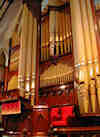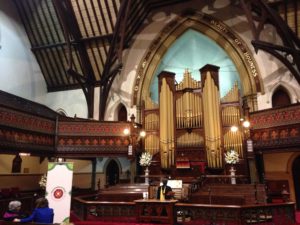
J.E. Dodd Pipe Organ
THE PIPE ORGANS AT WESLEY CHURCH KENT TOWN
Since opening in 1865 as the Wesleyan Jubilee Methodist Church, considerable importance has been given to music within the life of Wesley Uniting Church at Kent Town and in particular to the role of an excellent pipe organ.
The first pipe organ in the church was installed in 1873. Messrs. Harris and Waterhouse travelled to England to purchase the instrument from William Hill and Son at a cost of £400 which was donated by Mr Harris. It was installed high in the organ loft with access to the console from the rear at gallery level. An organist, William Pybus (later a City Organist), was engaged and paid £40 a year. Mr Daws was contracted, at a cost of £15 a year, to maintain the instrument and an “organ blower” was engaged for an annual remuneration of £8.
This organ was removed at the end of the nineteenth century and installed for short periods in the YMCA building in Adelaide and in Malvern Methodist Church. Since 1921 it has been in the Aberdeen Street Baptist Church, Geelong, Victoria. Although originally one of the largest organs in the colony, the major consideration for its removal was the general consensus that it was inadequate for accompanying the singing of the congregation at large gatherings.
The basis of the present organ was built in 1898 as the replacement for the original instrument. It was built in South Australia by J E Dodd and Sons and is recognised as one of the finest examples of the local organ builder’s work. At the time of its installation this was the largest church organ in the colony. Its specification was planned by the builder, J E Dodd, and the church organist, Dr E Harold Davies (later Elder Professor of Music, University of Adelaide). The quote for building the instrument was £873.9.0 with the blackwood case costing an additional £96 and the carvings on the case being £40. The old organ was sold for £310. The case consists of two towers and three flats. It is 7.6 m high, 6.1 m wide and richly ornamented. At the opening in December 1898, it was considered to be the largest and most imposing organ case in the colony with the exception of the one in the Adelaide Town Hall.
The instrument had 28 speaking stops across two manuals (each with 56 notes) and pedal board (with 30 notes). The stops were to the sides of the key boards and included a set of eight stop knobs, without the corresponding ranks of pipes, in anticipation of the addition of a third manual at some future time. The metal pipes were imported from England; the Diapason choruses and the Swell Cornopean were supplied by Bishop and the string stops together with the Great and Pedal reeds by Palmers. The wooden pipes were manufactured locally by Dodd. It had mechanical action, a water engine to produce the wind pressure in the bellows and chests with a backup hand pump for use in an emergency. The latter required up to six people to operate it. The new organ was considered to be the high water mark of organ building in the colony. Modifications were made to the sanctuary to permit the choir stalls and console of the considerably larger instrument to be placed in their present positions. The choir had previously sung from inadequate accommodation in the organ gallery.
In 1964 the Trustees of the church agreed to proceed with a number of additions and alterations to the instrument. The keyboards were replaced and extended to 61 notes in accordance with international standards and each of the associated ranks of pipes increased by five pipes. The pedal board was rebuilt to conform to accepted standards with radiating pedals which previously were curved in profile but rectangular in plan. The mechanical action, which had become uneven and always heavy to play due to the distance of the console from the pipes, was replaced with electro-pneumatic action. This also gave the advantage of extending the range of couplers, increasing the ranks of pipes on the pedals and the addition of adjustable pistons to the manuals and above the pedal board. The mechanical action for the foot pedal operating the Swell box enclosure was maintained. The opportunity was taken to rebuild the bellows and re-leather the chests. The enlarged organ consisted of 41 speaking stops.
These additions and alterations were made by Gunstar Organ Works to the specification prepared by the organ builders and the organist Dr Mark Symons. The upgraded mechanism of the organ permitted greater versatility in the scope of the tonal effects that could be achieved and the ease with which the instrument could be played.
During the 1980s, the Church Council agreed to pursue the augmentation of the organ to become the three manual instrument as originally envisaged (see above), and for the project to be led by the organist/choirmaster, Dr Mark Symons. At the same time it was to undergo a restoration program as parts of the organ had not been renovated since it was built almost a century earlier although it has always been maintained and fully playable. The condition for the project to proceed was that the work would be commenced once sufficient donations were received specifically for the project and that funds would not come from the regular giving for the work of the church. Initially donations were received and the fund gradually grew. In 2008 this increased dramatically with generous donations from members of the congregation and the wider community who were enthusiastic to see the project commence. Very large monetary gifts from Miss Margaret Davey and Mrs Jean Lang and gifts of ranks of pipes from the organ previously in the chapel at Prince Alfred College and from Mr David Clarke enabled the restoration and augmentation of the instrument to become a reality. Pipework from the College organ is of interest, including pipes made by Hill, Norman and Beard (Aust.) not otherwise seen in South Australia. That instrument was originally built for the house of a PAC old scholar, Mr A S H Gifford in Burwood, Melbourne, and bequeathed to the College.
A steering committee for the project held discussions with organ builders and organists, the specification for the work was prepared and early in 2009 the project commenced when David Clarke was organist/choirmaster. Adelaide organ builder Richard Larritt was engaged to do the work and this was completed in May 2012 with Graham Bell as organist/choirmaster.
To celebrate this achievement, a service of thanksgiving and dedication was held on Sunday 17 June. It was conducted by the minister at Kent Town, Rev Beatrice Panne, the preacher for the occasion was the Rev Barrie Hibbert and the music directed by Graham Bell. The opening recital was given on Friday 29 June by Dr Calvin Bowman, Director of Music at Wesley Uniting Church, Canberra and Senior Lecturer and Organist at the Australian National University.
Some additional maintenance work has been carried out since that time, and in late 2016 a significant and valuable further addition was made in the form of a Tuba stop, which had become available from the organ formerly in Maughan Uniting Church, Franklin Street. The recent enhancements have resulted in an instrument of international recital status with 62 speaking stops and over 3250 pipes, and which continues to lead the church’s weekly worship.
(Text by M.G. Symons, 2012; revised G.H. Bell 2018)
ORGAN SPECIFICATION as from December 2016
SWELL (enclosed)
1. Lieblich Bourdon 16
2. Geigen Principal 8
3. Hohl Flute 8
4. Viol d’Orchestre 8
5. Viol Celeste (T.C.) 8
6. Octave 4
7. Flauto Traverso 4
8. Nazard 2 2/3
9. Fifteenth 2
10. Flautina 2
11. Mixture III
12. Sharp Mixture II
13. Double Trumpet 16
14. Cornopean 8
15. Oboe 8
16. Vox Humana 8
i. Sub Octave ii. Unison Off
iii. Octave Tremulant CHOIR (enclosed)
32. Diapason 8
33. Koppel Flute 8
34. Gedact 8
35. Salicional 8
36. Vox Angelica 8
37. Gemshorn 4
38. Koppel Flute 4
39. Nazard 2 2/3
40. Piccolo 2
41. Tierce 1 3/5
42. Larigot 1 1/3
43. Mixture III
44. Clarinet 8
45. Posaune 8 (unenclosed)
46. Tuba 8 (unenclosed)
x. Sub Octave xi. Unison Off
xii. Octave xiii.Swell Sub to Choir
xiv. Swell to Choir xv. Swell Octave to Choir
Tremulant
GREAT
17. Bourdon 16
18. Open Diapason 8
19. Viola 8
20. Claribel 8
21. Lieblich Gedact 8
22. Dulciana 8
23. Principal 4
24. Harmonic Flute 4
25. Twelfth 2 2/3
26. Fifteenth 2
27. Sesquialtera III
28. Mixture II
29. Trumpet 8
30. Posaune 8
31. Clarion 4
iv. Swell Sub to Great v. Swell to Great
vi. Swell Octave to Great vii. Choir Sub to Great
viii. Choir to Great ix. Choir Octave to Great PEDAL
47. Grand Open 16
48. Open Diapason 16
49. Bourdon 16
50. Echo Bourdon 16
51. Quint 10 2/3
52. Principal 8
53. Violoncello 8
54. Flute 8
55. Octave Quint 5 1/3
56. Fifteenth 4
57. Flute 4
58. Mixture III
59. Ophicleide 16
60 Double Trumpet 16
61 Trumpet 8
62 Clarion 4
xvi. Swell to Pedal xvii. Great to Pedal
xviii. Choir to Pedal
ACCESSORIES
Swell and Pedal Pistons Coupled Great and Pedal Pistons Coupled
Thumb Piston Setter Capture Action – 10 Levels of Memory
5 Thumb Pistons to Swell 5 Thumb Pistons to Great 5 Thumb Pistons to Choir
5 Toe Pistons to Pedal 8 General Thumb Pistons 8 General Toe Pistons
1 Thumb Piston General Cancel Reversible Thumb Pistons for main couplers
WESLEY UNITING CHURCH
KENT TOWN
THE PIPE ORGAN
l